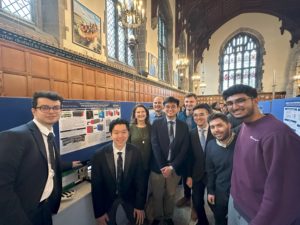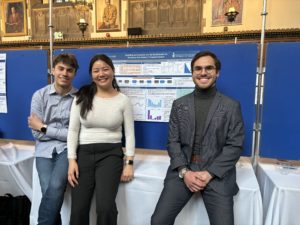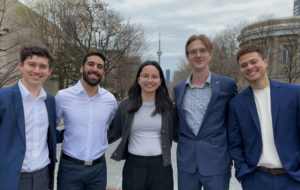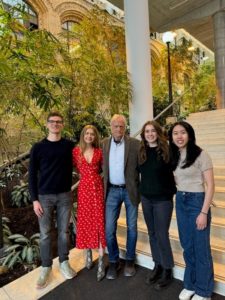The end of term saw fourth-year Mechanical and Industrial Engineering students culminate their year-long Capstone Design projects at the annual MIE Capstone Design Showcase. A total of 80 teams, comprising over 330 students, presented their prototypes, posters, and final recommendations to faculty and industry clients at Hart House. The caliber of projects was outstanding and offered innovative solutions to all of the clients involved with some of those projects receiving awards. The MIE490 and MIE491 award winners are listed below.
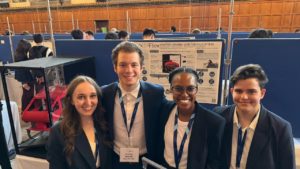
1st Place Capstone Design Project Award (Mechanical) and John H. Weber Scholarship
Project Title: Adaptive Landing Gear for Helicopters / Project Supervisor: Professor Matthew Mackay
SAFRAN Landing Systems wanted to design a safer way for rescue helicopters to land on steep terrain and team members Samantha Butt, Lydia Callender, Jeremy Mainella, and Ana Vukojevic delivered. The result is “AeroFlex” – an innovative flexure-based landing gear prototype that is lightweight and adapts to a 20-degree sloped terrain. Rescue helicopters can perform safer and more efficient maneuvers in mountainous terrain in response to the thousands of calls the Canada National Search & Rescue program receives each year.
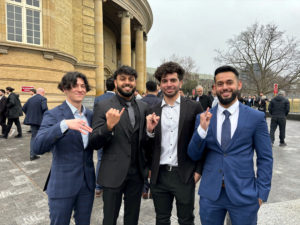
1st Place Capstone Design Project Award (Industrial) and Peri Family Industrial Engineering Design Award
Project Title: InfraPOV: Infrastructure Public Opinion Visualizer / Project Supervisor: Professor Scott Sanner
Numerous stakeholders participate in the development of large-scale infrastructure projects. Mott MacDonald wanted to move away from the industry standard of manually evaluating comments and concerns to provide their clients with more accurate data to reflect constituent voices. Enter “InfraPOV: Infrastructure Public Opinion Visualizer” a design by Capstone team Varun Kamboj, Mika Sustar, Marzuk Khan, and Matin Sarahi, which leverages Large Language Model technology to sum up and categorize huge swaths of data from unstructured comments. Time spent analyzing stakeholder data was reduced by 95%, offering Mott MacDonald a more efficient way to extract insights from public opinion and provide clients with meaningful solutions.
|
|
|
2nd Place Capstone Design Project Award (Mechanical & Industrial)
Project Title: Thermal Characterization and Simulation Framework of Large-Format Electric Vehicle Lithium-Ion Batteries / Project Supervisor: Professor Cristina Amon
Lithium-ion battery performance and safety can be negatively affected by the heat generated during charging and discharging. The ATOMS Laboratory team produced an innovative experimental approach to characterize and enhance the thermal performances of novel battery systems. Team members Daniel Lee, John Abellanoza, Noah D’Emilio, and Mitchell Chong, designed and prototyped several cell test rigs and accurately incorporated realistic operating conditions of battery cells in commercial electric vehicles (EVs) and stationary battery energy storage systems (BESS). The team added I-shaped cooling fins to the battery module design to create more equal temperature distribution across the cell and lowering overall temperature by 10% to enable faster charging.
Project Title: Modelling and Evaluation of a Tier-Based System for Grandview Kids Children’s Treatment Centres / Project Supervisor: Professor Vahid Sarhangian
Reducing rehabilitation wait times is a priority for Grandview Kids (GVK), a Children’s Treatment Centre. Using simulation modeling, the Capstone team of Max Beggs, Claire Shaw, and Jose Pablo Siliézar analyzed the effects of a tiered intervention system to improve patient flow. Moving away from the current non-tiered system of assessments and 1-on-1 appointments, the team constructed a simulation model in Python to include Tier 1 Workshops and Tier 2 Group Therapy interventions to provide temporary treatment options to patients. This tiered system was found to decrease queue sizes and wait times by up to 20% and provided evidence-based recommendations to enhance patient flow management and provide equitable access to care for children with developmental delays.
|
|
|
3rd Place Capstone Design Project Award (Mechanical & Industrial)
Project Title: Experimental Methodology For Measuring Propeller Noise / Project Supervisor: Professor Kamran Behdinan
Drones in aviation are noisy and as they are used more frequently, the increase in noise levels is cause for concern. Tiffany Costas, Daniel Roberts, Adli Hijab, Peter James Mason, and Nicholas Bajaikine worked with their ARL-MLS Laboratory client to find a solution. An optimal propeller design is a promising way to mitigate noise pollution and collecting noise data to determine efficacy was the team’s objective. The result was a testing apparatus prototype that measured detailed and flexible propeller noise characterization from many different propeller geometries. This final product offers the flexibility of rapid testing within the lab at a lower cost than the current market alternatives.
Project Title: Emergency Department Resource & Scheduling Allocation to Optimise Efficiency / Project Supervisor: Professor Michael Carter
Project client Humber River Health (HRH) has the busiest Emergency Department (ED) in Ontario and wants to find ways to optimize patient flow and reduce wait times. Team members Andrew Barton, Emma Beaumount, Maia Kanceljak, and Alexandra Hon used simulation technology and data analytics to find solutions. Following an ambulatory patient’s journey until seen by a physician, the team determined that reallocating nurse staffing numbers at different shift stages would reduce time-to-physician initial assessments (PIA), and minimize overall wait times.
-Published by Kendra Hunter on May 16, 2024
